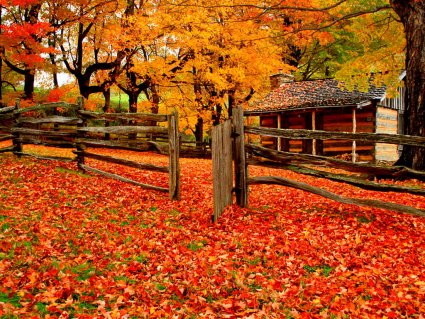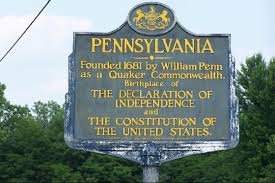US State of Pennsylvania
Pennsylvania , officially the Commonwealth of Pennsylvania, is a U.S. state that is located in the Northeastern and Mid-Atlantic regions of the United States, and the Great Lakes region. The state borders Delaware to the southeast, Maryland to the south, West Virginia to the southwest, Ohio to the west, Lake Erie and Ontario, Canada to the northwest, New York to the north and New Jersey to the east. The Appalachian Mountains run through the middle of the state.
Pennsylvania is the 33rd most extensive, the 6th most populous, and the 9th most densely populated of the 50 United States. The state's four most populous cities are Philadelphia, Pittsburgh, Allentown, and Erie. The state capital is Harrisburg. Pennsylvania has 51 miles (82 km) of coastline along Lake Erie and 57 miles (92 km) of shoreline along the Delaware Estuary. The state is one of the 13 original founding states of the U.S.
Pennsylvania is 170 miles (274 km) north to south and 283 miles (455 km) east to west. Of a total 46,055 square miles (119,282 km2), 44,817 square miles (116,075 km2) are land, 490 square miles (1,269 km2) are inland waters, and 749 square miles (1,940 km2) are waters in Lake Erie. It is the 33rd largest state in the United States. Pennsylvania has 51 miles (82 km) of coastline along Lake Erie and 57 miles (92 km) of shoreline along the Delaware Estuary.
The bounds of the state are the Mason–Dixon line (39° 43' N) to the south, the Twelve-Mile Circle on the Pennsylvania-Delaware border, the Delaware River to the east, 80° 31' W to the west and the 42° N to the north, with the exception of a short segment on the western end, where a triangle extends north to Lake Erie.
Pennsylvania borders six other states: New York to the north; New Jersey to the east; Delaware and Maryland to the southeast; West Virginia to the southwest, and Ohio to the west. Pennsylvania also shares a water border with the Canadian province of Ontario. Of the original Thirteen Colonies, Pennsylvania is the only state that does not border the Atlantic Ocean.
It has the cities of Philadelphia, Reading, Lebanon and Lancaster in the southeast, Pittsburgh in the southwest, the tri-cities of Allentown, Bethlehem, and Easton in the central east (known as the Lehigh Valley), the tri-cities of Scranton, Wilkes-Barre, and Hazleton in the northeast, and Erie in the northwest. Williamsport serves as the "hub" of the commonwealth's north-central region, with York and the state capital Harrisburg on the Susquehanna River in the central region of the commonwealth.
There are 5 regions. They are the Allegheny Plateau, Ridge and Valley, Atlantic Coastal Plain, Piedmont, and the Erie Plain.
Pennsylvania's diverse topography also produces a variety of climates, though the entire state experiences cold winters and humid summers. Straddling two major zones, the majority of the state, with the exception of the southeastern corner, has a humid continental climate (Köppen climate classification Dfa). Greater Philadelphia has some characteristics of the humid subtropical climate (Köppen Cfa) that covers much of Delaware and Maryland to the south.
Moving toward the mountainous interior of the state, the winter climate becomes markedly colder, the number of cloudy days increases, and snowfall amounts are greater. Western areas of the state, particularly locations near Lake Erie, can receive over 100 inches (250 cm) of snowfall annually, and the entire state receives plentiful precipitation throughout the year. The state may be subject to severe weather from spring through summer into fall; an average of 10 tornadoes touch down each year in the state.


Education in Pennsylvania
The University of Pennsylvania quadrangle in Philadelphia. Pennsylvania has 500 public school districts, thousands of private schools, publicly funded colleges and universities, and over 100 private institutions of higher education.
Primary and secondary education
In general, under state law, school attendance in Pennsylvania is mandatory for a child from the age of 8 until the age of 17, or until graduation from an accredited high school, whichever is earlier.[105] As of 2005, 83.8% of Pennsylvania residents age 18 to 24 have completed high school. Among residents age 25 and over, 86.7% have graduated from high school. Additionally, 25.7% have gone on to obtain a bachelor's degree or higher. State students consistently do well in standardized testing. In 2007, Pennsylvania ranked 14th in mathematics, 12th in reading, and 10th in writing for 8th grade students.
In 1988, the Pennsylvania General Assembly passed Act 169, which allows parents or guardians to homeschool their children as an option for compulsory school attendance. This law specifies the requirements and responsibilities of the parents and the school district where the family lives.
Higher education
The Pennsylvania State System of Higher Education (PASSHE) is the public university system of the Commonwealth, with 14 state-owned schools. The Commonwealth System of Higher Education is organizing body of the 4 state-related schools in Pennsylvania, these schools are independent institutions that receive some state funding. There are also 15 publicly funded two-year community colleges and technical schools that are separate from the PASSHE system. Additionally there are many private two- and four-year technical schools, colleges and universities.
Carnegie Mellon University, The Pennsylvania State University, the University of Pennsylvania, and the University of Pittsburgh, are members of the Association of American Universities, an invitation only organization of leading research universities. The Pennsylvania State University is the Commonwealth's Land-grant university, Sea Grant College and, Space Grant College. The University of Pennsylvania, located in Philadelphia, is considered the first university in the United States and established the country's first medical school. The University of Pennsylvania is also the Commonwealth's only, and geographically the most southern, Ivy League school. The Pennsylvania Academy of the Fine Arts is the first and oldest art school in the United States.[109] Philadelphia College of Pharmacy, now a part of University of the Sciences in Philadelphia, was the first pharmacy school in the United States.












